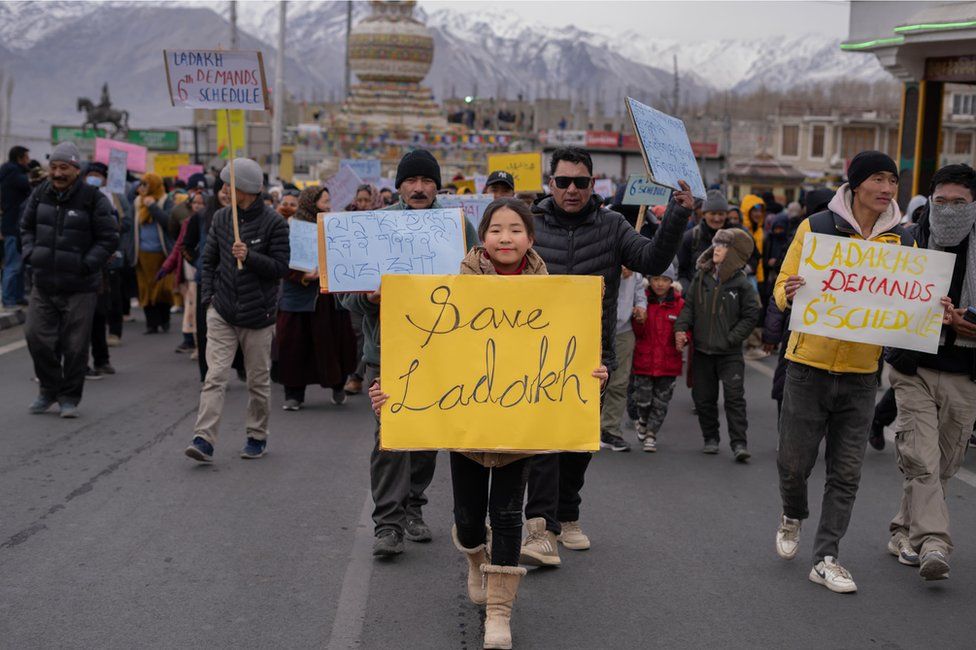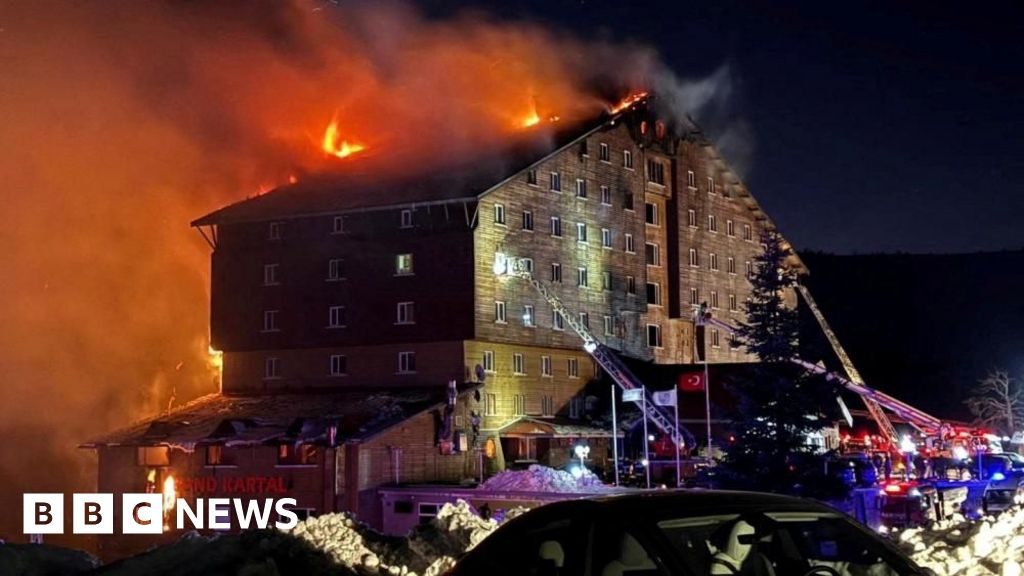ARTICLE AD BOX
 Image source, Auqib Javeed
Image source, Auqib Javeed
Young people in the region say they are concerned about employment and the recruitment process for government jobs.
In India's high-altitude Ladakh region, nearly 1,500 Buddhists are protesting in sub-zero temperatures. In 2019, the government fulfilled their longstanding demand for a region separate from Indian-administered Kashmir. But since 2020, they have frequently taken to streets, accusing the government of "betrayal" and unkept promises. Auqib Javeed reports on what's changed.
Ladakh, India's northern-most region, is a desert inhabited by 300,000 people from the Muslim and Buddhist communities. The Leh region is dominated by Buddhists while the Kargil region is inhabited by Shia Muslims.
For decades, the Buddhist community demanded a separate region for its people, while those in Kargil wanted to be integrated with the Muslim-majority region of India-administered Kashmir.
In 2019, Prime Minister Narendra Modi's government revoked Article 370 of the constitution which accorded special status to the former state of Jammu and Kashmir and gave it significant autonomy.
The state was then divided into two parts - Ladakh, and Jammu and Kashmir - and both are federally administered territories.
"We were demanding a separate territory with a legislature," says Chhering Dorjey Lakrook, a veteran Buddhist leader from Leh. "But we were granted only a federally governed territory."
For people in Ladakh, who depend primarily on agriculture, the move also sparked fears it would affect the region's culture and identity as it made it easier for those from outside the region to buy land in the area.
According to India's home ministry, as of 5 April 2023, no Indian company had invested in Ladakh in the past three years, nor had anyone from outside purchased any land.
But residents remain apprehensive about an influx like in Jammu and Kashmir where, data shows, 185 outsiders have bought land between 2020-22.
In 2020, Kargil and Leh districts joined hands and formed the Leh Apex Body (LAB) and Kargil Democratic Alliance (KDA), aimed at addressing people's concerns. The civil society groups have held massive rallies against the federal government.
Image source, Auqib Javeed
Image caption,Thousands of people have taken to the streets in protest against the federal government
Their demands include statehood for Ladakh, jobs, protection of their land and resources, and a parliamentary seat each for Leh and Kargil districts.
They also want implementation of the Sixth Schedule, a constitutional provision that protects tribal populations and allows them to set up autonomous organisations that frame laws on land, health and agriculture. Nearly 97% of Ladakh's population is tribal.
"The Sixth Schedule was designed to protect the rights of indigenous and tribal groups," says Chhering Dorjey Lakrook, who until 2020 was president of the regional unit of India's governing Bharatiya Janata Party (BJP). This, he adds, will save them from exploitation by industrialists.
The federal home ministry set up a committee to discuss these demands, but locals say there has been no progress.
Young people in the region are also concerned about not getting government jobs.
Padma Stanzin, who heads Ladakh Students' Environmental Action Forum (Leaf), says since 2019, not a single person has been recruited in a senior government role. "We fear our jobs will be taken over by outsiders," she adds.
Ladakh's BJP MP Jamyang Tsering Namgyal did not respond to BBC's request for comments.
Image source, Auqib Javeed
Image caption,Ladakh residents remain apprehensive the region will be thrown open for investors like Jammu and Kashmir has been
Ladakh holds significant geostrategic importance for India as it shares borders with both China and Pakistan, the two countries which strongly condemned India's decision to revoke Article 370.
While Indian-administered Kashmir witnessed a protracted armed uprising against Delhi's rule starting in late 1980s, the militancy never spread to Ladakh.
In the 1999 Kargil war with Pakistan, residents in Ladakh volunteered support by supplying food and other essentials to Indian soldiers.
Residents now wonder if they are paying the price for being "loyal".
"The spirit of that voluntarism will not remain if the government hurts the sentiments of the people," says Sonam Wangchuk, an engineer, innovator and climate activist, who has worked for years to address local community needs.
Mr Wangchuk, who gained fame after Bollywood star Aamir Khan played a character based on him in the 2009 blockbuster Three Idiots, is on a 21-day-long fast "to remind the government of its promises to safeguard Ladakh's environment and tribal indigenous culture".
People of Ladakh, he says, have offered support to Indian soldiers, including to personnel from the plains who have struggled to adapt to high altitude. "Any kind of disturbance will impact this spirit," he adds.
Image source, Getty Images
Image caption,Since 2020, the people of Ladakh have frequently taken to streets, citing "betrayal" and unkept promises
Experts say China and Pakistan would watch for any sign of "weakness" in the region.
"Unrest and discontent, especially if sustained, is something that Beijing and Islamabad could try to exploit," says Michael Kugelman, director of Washington-based think-tank South Asia Institute at the Wilson Centre.
Beijing didn't recognise the creation of Ladakh as a federally-governed territory in 2019. The region lies along the disputed 3,440km (2,100 mile)-long de facto border along the Himalayas - called the Line of Actual Control, or LAC - which is poorly demarcated.
Since 2020, tensions between India and China have been high after their forces clashed in the Galwan river valley in Ladakh, which left at least 20 Indian soldiers dead.
Following the clashes, both Delhi and Beijing increased troop movement and built massive military infrastructure along the LAC. China launched incursions in Ladakh, claiming over 1,000 sq km of India-claimed territory. India has repeatedly denied China's claim.
Incidents of Chinese soldiers entering Ladakh and restricting residents from grazing their herds have added to local grievances.
In January, a group of local herders clashed with Chinese People's Liberation Army (PLA) soldiers after they were prevented from taking their cattle to traditional grazing lands near the LAC.
Mr Kugelman argues that while India cannot afford an unstable Ladakh, it is also not possible to reverse the changes made in 2019.
Delhi's position has always been that the repeal of Article 370 and moves associated with it were final and would bring an end to any disputes and instability within the regions affected.
"Changing the status of Ladakh and giving it statehood would undermine that position and raise questions about the merits of making those moves back in 2019 and that's not the impression that Delhi would like to convey," he explains.
Praveen Donthi, a senior analyst for the International Crisis Group, a Delhi think-tank, says this is most likely why India refuses to extend powers to the local government in Ladakh.
"The LAC is unstable since the Galwan clash and the government probably would like to tread carefully," he says.
Ladakh residents, however, hope the strength of their unity - the joint action by the Muslim and Buddhist communities - will eventually force the authorities to address their grievances.
"Our unity will compel the government to hear us and address our demands," says Jigmat Paljor, a student-activist in Leh. "They can't ignore us for too long."

 10 months ago
80
10 months ago
80








 English (US) ·
English (US) ·